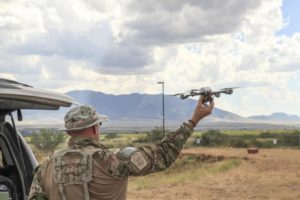Source:CBP
U.S. Border Patrol agents used a search drone to locate three women reported missing amid a heat wave last week, highlighting a positive outcome for the agency’s oft-beleaguered program.
The three women, who agents say had entered the country illegally, called 911 to report they were lost somewhere in the desert north of the Highway 86 Checkpoint near Calexico, Calif.
The agency deployed a search drone team and, within 45 minutes, found the women, treating them for dehydration.
“There was no water or shade available in the remote area of the desert where the three women were located,” a CBP press release stated. “The three individuals stated that they were dropped off south of the checkpoint with no food or water and with no intention of being picked up again.”
“The three women, two unaccompanied juveniles and one adult, all Mexican nationals, were immediately expelled back to their country of origin,”
Since 2006, the agency has also used Predator B drones, a version of the U.S. military’s MQ-9 Reaper drone, along the border.
According to a Cato study: “In September 2017, CBP began testing smaller hand-launched drones, including AeroVironment’s Raven and Puma small unmanned aircraft systems.”
In terms of the search drone program’s legality, a Vox report notes:
“With regard to where these devices are allowed to fly, CBP says it largely uses these drones within the ‘immediate border area’ within 25 miles of the border. Legally, the agency is restricted by the Federal Aviation Administration to fly drones between 25 and 60 miles of the US-Mexico border, excluding urban areas.”
“Between October 2018 and April 2019, US Border Patrol flew these sUAS devices for a total of around 176 flight hours, resulting in 474 apprehensions of individuals at the border.”
Writing for Cato, authors David J. Bier and Matthew Feeney criticized the drone program’s effectiveness:
“CBP’s drone program has failed to live up to its expectations. Its expense, disproportionately small contribution to border security, and infringement on Americans’ privacy are good reasons for CBP to wind down its drone program. However, if CBP does continue to use drones, it should further constrain their use to prevent unnecessary data collection of Americans.”
Jason is a longstanding contributor to DroneLife with an avid interest in all things tech. He focuses on anti-drone technologies and the public safety sector; police, fire, and search and rescue.
Beginning his career as a journalist in 1996, Jason has since written and edited thousands of engaging news articles, blog posts, press releases and online content.
Email Jason
TWITTER:@JasonPReagan
Subscribe to DroneLife here.
https://dronelife.com/2020/06/04/border-patrol-search-drone-finds-lost-women/
